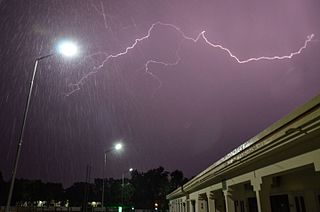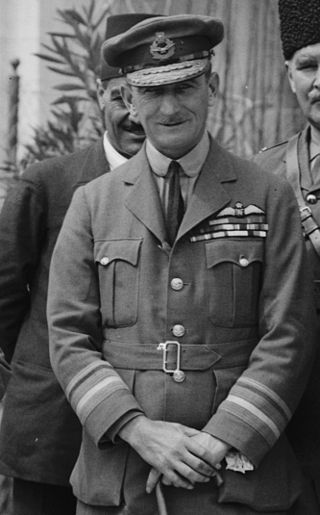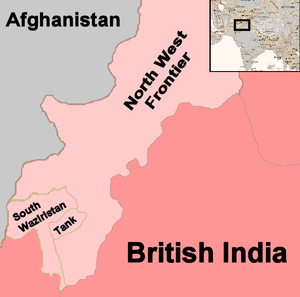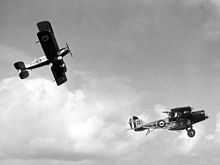Waziristan is a mountainous region covering the North Waziristan and South Waziristan districts of the Pakistani province of Khyber Pakhtunkhwa. Waziristan covers around 11,585 square kilometres (4,500 sq mi) and is mainly populated by the Wazir Pashtun tribe, who speak the Waziri dialect of the Pashto language.

Number 1 Squadron, also known as No. 1 (Fighter) Squadron, is a squadron of the Royal Air Force. It was the first squadron to fly a VTOL aircraft. It currently operates Eurofighter Typhoon aircraft from RAF Lossiemouth.

No. 27 Squadron of the Royal Air Force operates the Boeing Chinook from RAF Odiham.

The North-West Frontier was a region of the British Indian Empire. It remains the western frontier of present-day Pakistan, extending from the Pamir Knot in the north to the Koh-i-Malik Siah in the west, and separating the modern Pakistani frontier regions of North-West Frontier Province, Federally Administered Tribal Areas and Balochistan from neighbouring Afghanistan in the west. The borderline between is officially known as the Durand Line and divides Pashtun inhabitants of these provinces from Pashtuns in eastern Afghanistan.

Marshal of the Royal Air Force Sir Edward Leonard Ellington, was a senior officer in the Royal Air Force. He served in the First World War as a staff officer and then as director-general of military aeronautics and subsequently as controller-general of equipment. In the inter-war years he held command positions in the Middle East, in India and then in Iraq. He served as Chief of the Air Staff in the mid-1930s and in that role he implemented a plan, known as 'Scheme F'. This scheme implemented an increase in the size of the Royal Air Force to 187 squadrons within three years to counter the threat from Hitler's Germany. He also broke up the command known as "Air Defence of Great Britain" to create RAF Fighter Command, RAF Bomber Command, RAF Coastal Command and RAF Training Command. He then served as Inspector-General of the RAF until his retirement in 1940.

Marshal of the Royal Air Force Sir John Maitland Salmond, was a British military officer who rose to high rank in the Royal Flying Corps and then the Royal Air Force. During the First World War he served as a squadron commander, a wing commander and then as General Officer Commanding the RAF on the Western Front towards the end of the war. He went on to be Air Officer Commanding British Forces in Iraq in the early 1920s when he halted a Turkish invasion and sought to put down a Kurdish uprising against King Faisal, the British-sponsored ruler of Iraq. He was Chief of the Air Staff in the early 1930s and bitterly opposed the position taken by British politicians at the World Disarmament Conference in Geneva, which would have led to the UK's complete aerial disarmament. In the event the talks broke down when Adolf Hitler withdrew from the Conference in October 1933.

Risalpur is a city in Nowshera District, Khyber-Pakhtunkhwa, Pakistan, on the Nowshera-Mardan Road. It is nearly 45 km from Peshawar and 18 km from Mardan and is located at 34°4'52N 71°58'21E. In a basin some 1014 feet above sea level, it is bounded on the south and west by the Kabul and Kalpani rivers, respectively. The famous Khyber Pass lies 90 kilometers to the north.

Air Chief Marshal Sir William Geoffrey Hanson Salmond, was a senior commander in the Royal Flying Corps during the First World War. Remaining in the Royal Air Force after the war, he held senior appointments in the Middle East, Great Britain and India. In late 1928 and early 1929, he directed the evacuation from Kabul of British embassy staff and others, by air.
The Mahsud or Maseed is a Karlani Pashtun tribe inhabiting mostly the South Waziristan Agency in Khyber Pakhtunkhwa province of Pakistan.

The Indian General Service Medal was a campaign medal approved on 1 January 1909, for issue to officers and men of the British and Indian armies. From 1919, it was also awarded to officers and men of the Royal Air Force, with the Waziristan 1925 clasp awarded solely to the RAF.
Mulla Powinda or Mullah Powindah, born Mohiuddin Maseed (1863–1913), was a religious leader and a freedom fighter from the Pashtun tribe of the Shabi khel Mahsuds, based in Waziristan. He was from Marobi Shabikhel, a village in the present-day Makin Subdivision of South Waziristan, Pakistan. He led a long-standing guerrilla insurgency against the British colonial forces in the late 19th century. And came to prominence by getting the two elders of the Jirga, who were responsible for handing over two Mahsuds wanted by the British authorities for killing a British officer of the Works department. to the Political Agent in 1893.

Air Commodore Richard Charles Montagu Pink, was a senior officer in the Royal Air Force (RAF). He distinguished himself during service with the Royal Navy and Royal Naval Air Service in the First World War, before joining the RAF shortly after its creation in 1918. He is the namesake of Pink's War, which was the first campaign conducted by the RAF alone and the only campaign to be named after an RAF officer.
No. 5 Wing of the Royal Air Force was a wing of aircraft squadrons which was originally established as the Fifth Wing of the Royal Flying Corps. Currently inactive, the wing has been formed and disbanded five times over the course of its history.
Air Chief Marshal Sir John Wakeling Baker, was a senior commander in the Royal Air Force in the mid-20th century.
The Waziristan campaign 1936–1939 comprised a number of operations conducted in Waziristan by the British Indian Army against the fiercely independent tribesmen that inhabited this region. These operations were conducted in 1936–1939, when operations were undertaken against followers of the Pashtun nationalist Mirzali Khan, also known by the British as the "Faqir of Ipi", a religious and political agitator who was spreading anti-British sentiment in the region and undermining the prestige of the Indian government in Waziristan at the time.

Air Vice Marshal William Ernest Staton, was a British airman who began his career as a First World War flying ace credited with 26 victories. He was transferred to the Royal Air Force (RAF) on its creation in 1918 and remained in the RAF during the inter-war years. During the Second World War he served in England and pioneered the bombing technique of using pathfinders to mark targets. He then served in the Far East before becoming a prisoner of war to the Japanese. After the war he returned to Great Britain and the RAF where he reached air rank and twice captained the British Olympic Shooting Team.

The Waziristan campaign 1919–1920 was a military campaign conducted in Waziristan by British and Indian forces against the fiercely independent tribesmen that inhabited this region. These operations were conducted in 1919–1920, following the unrest that arose in the aftermath of the Third Anglo-Afghan War.

Makeen or Makin (ماکین) is a city in the South Waziristan region of Khyber Pakhtunkhwa, Pakistan. It is located on the boundary of the North Waziristan district. On its west, it shares a border of 40 Km with Afghanistan's Barmal District and Paktika.
Air Vice-Marshal Arthur John Capel, was a senior Royal Air Force officer.













